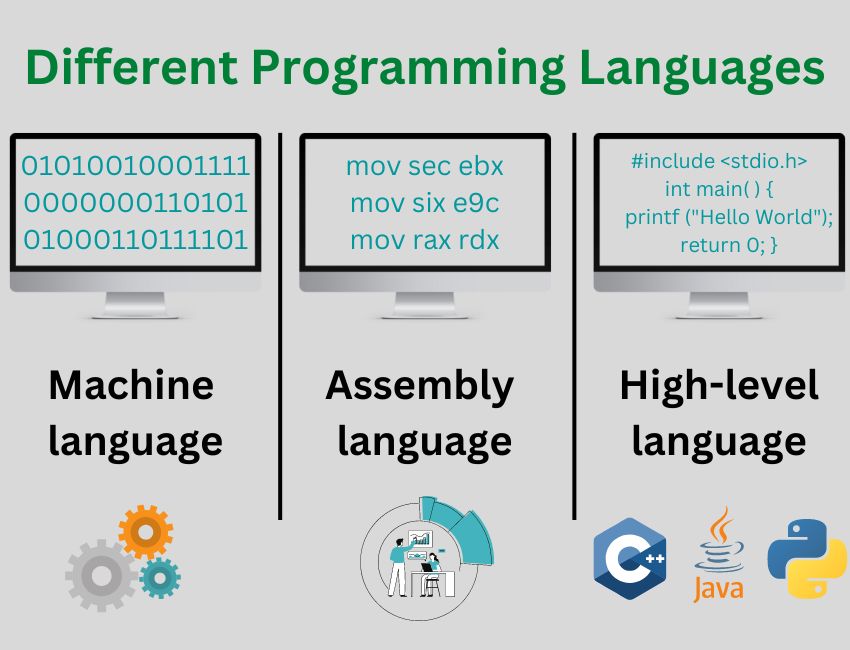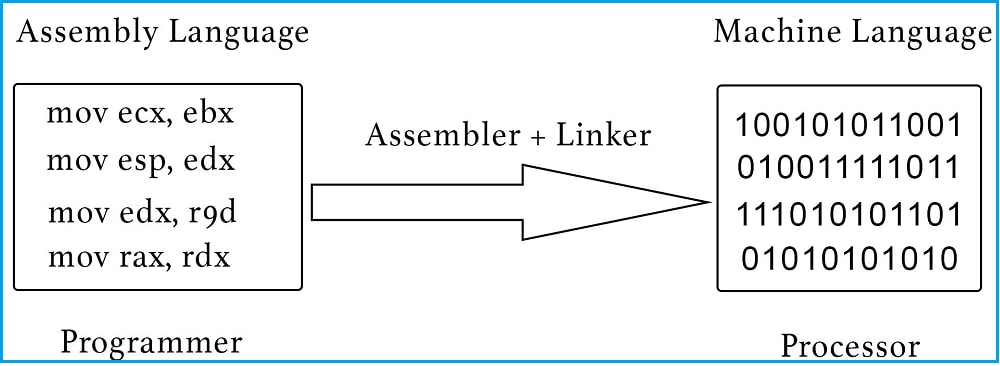In this course, we will study different programming languages like Machine language, Assembly language and High-level language, and the Difference between Assembly Language and Machine Language and their advantages and disadvantages.
What are the different programming languages used?
There are various programming languages that can be used for writing programs and applications but now in this post, we will discuss 8 Difference between Assembly Language and Machine Language. They are the list of different programming languages:
The CPU can only understand the language of ones and zeroes that is machine language. It is the first generation of programming languages. It was used in ancient times but it was hard to memorize and modify.
So the second generation of programming languages was developed, that is assembly language, the assembly language consists of English mnemonics. The assembly language was much easier to understand and memorize. Modification in the language can be done more easily. The assembly language is converted into machine language using a compiler.
Further, the third generation of programming languages was developed named the high-level language. It is completely English language and easy to understand and memorize. The high-level language is converted into assembly language with the help of an interpreter.
What is machine language?
The machine language comprises the bits. As we all know for computers to understand the commands provided in high-level languages the instructions have to be converted into machine language that comprises bits. The compiler or interpreter conversion of a high-level language to machine language. Below I have written about the Difference between Assembly Language and Machine Language, I hope that you will also like it.
- Machine language includes zeros and ones. As we know that computers are in the form of digital electronic devices thus they use binary digits for performing their operations.
- One showcases the true or on state while zero depicts the false or off state in machine language.
- The method of converting high-level language programs to machine language codes depends on the CPU.
What are the advantages of machine language?
- The fast and efficient use of the computer can be done by using machine language.
- It requires no translator to translate the code. It is directly understood by the computer.
What are the disadvantages of machine language?
- All operation codes have to be remembered.
- All memory addresses have to be remembered.
- Finding errors in a program written in machine language is hard.
What is assembly language?
The assembly language acts as the intermediate language between the two-machine language and high-level programming languages. Assembly language is easier to comprehend and use as compared with machine language; however, it is more complex than high-level programming languages. The next topic I have written about is the Difference between Assembly Language and Machine Language.
- Assembly language is often called a low-level language as it is closer to the hardware level.
- Understanding of register structure and computer architecture should be there in programmers using assembly language codes.
- A specialized compiler known as an assembler is used for converting assembly language commands to object code or machine code.
- Assembly language statements comprise four sections. These are mnemonic, operand, label, and comment (the last two sections are optional).
- The mnemonics in assembly language give us the instructions to execute commands; operands are parameters put in use for the command.
- Macros are also supported in the assembly language which is a set of commands with a name.
What are the advantages of assembly language?
- Easy to understand and use
- Easy to locate and correct errors
- Easy to modify
- No worries about addressing
- Efficient that machine language
What are the disadvantages of assembly language?
- There is a requirement for knowledge of the processor architecture and instruction set.
- Machine language coding.
- Many instructions are required to achieve small tasks.
- Source programs tend to be larger and difficult to follow.
Difference between Assembly Language and Machine Language
Difference between Assembly Language and Machine Language Before knowing who, we must know that Assembly language and machine language are both low-level programming languages, but there are some key differences between them.
| Assembly language | Machine language |
|---|---|
| It is an intermediate programming language. | It is a low-level language. |
| Assembly language uses English syntax and hence it is easier to understand. | Machine language uses zeroes and ones and is not that much easier to understand. |
| This language is easily understandable by the programmers but not by the CPU. | This language is harder to be understood by the programmer and can be easily understood by the CPU. |
| They are second-generation programming languages. | They are first-generation programming languages. |
| The codes and instructions can be easily memorized by the user. | The binary codes can’t be easily memorized. |
| Modification can be done very easily. | Modification can not be done easily. |
| They are not platform-dependent. | They are platform-dependent and their features vary accordingly. |
| There is a need for a compiler for executing commands. | There is no need for any sort of compiler for executing commands. |
The instruction set of the Intel 8085 microprocessor according to the assembly language
- ADD r – add
- ADD M -add to the memory
- ADC r -add with carry
- Add M -add with carry to memory
- LDI -load immediate
- LDA -load accumulator direct
- SLA -shift contents of the register one place to the left
- MOV -move data
- MOV M A -move result from memory to register A
- STA -store on the register
- STA a -store to the accumulator
- JMP -jump
- SUB r -subtract
- SUB M -subtract memory
- Cy -carry
What is High-Level Language?
A high-level language is a type of programming language that is designed to be easy for humans to read, write, and understand. High-level languages are not designed to be run on a computer directly but instead are meant to be converted into a low-level language, which can be run on a computer.
An example of a High-Level language
Thanks for spending your time learning the Difference between Assembly Language and Machine Language. I hope you guys like this tutorial.


